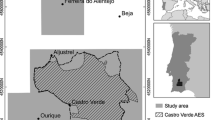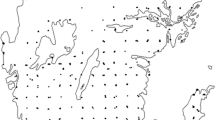Abstract
Agricultural intensification is a major cause for biodiversity loss. It occurs at field scales through increased inputs and outputs, and at landscape scales through landscape simplification. Agri-environment schemes (AES) of the European Common Agricultural Policy (CAP) aim at reducing biodiversity loss by promoting extensification of agricultural practises mostly at field scales. We present a conceptual model for the relationship between landscape complexity and ecological effectiveness of AES based on (a) non-linear relationships between landscape complexity and abundance and diversity at field scales and (b) four possible interactive scenarios between landscape- and field scale effects on abundance and diversity. We then evaluated whether and how effectiveness of AES interacted with landscape-scale effects of intensification along a landscape complexity gradient established in central Spain. Pairs of cereal fields with and without AES but with the same landscape context were selected in three regions differing in landscape complexity. Effectiveness of AES was measured as differences between paired fields in species richness and abundance of five target groups (birds, grasshoppers and crickets, spiders, bees and plants). Landscape metrics were measured in 500–m radius circular plots around field centres. Positive, negative and no effects of landscape complexity on effectiveness of AES were found, suggesting that effects of complexity on effectiveness of AES changes from positive to negative along gradients of landscape complexity. Effectiveness of AES for improving biodiversity was then constrained by landscape. Compulsory measures aimed at enhancing or maintaining landscape complexity would enhance the effectiveness of AES for preserving biodiversity in farmed landscapes.





Similar content being viewed by others
References
Aviron S, Burel F, Baudry J, Schermann N (2005) Carabid assemblages in agricultural landscapes: impacts of habitat features, landscape context at different spatial scales and farming intensity. Agric Ecosyst Environ 108:205–217
Bailey D, Billeter R, Aviron S, Schweiger O, Herzog F (2007) The influence of thematic resolution on metric selection for biodiversity monitoring in agricultural landscapes. Landsc Ecol 22:461–473
Banaszak J (1980). Studies on methods of censusing the number of bees (Hymenoptera, Apoidea). Pol Ecol Studies 6:355–366
Batáry P, Baldi A, Szél G, Podlussány A, Rozner I, Erdós S (2007) Responses of grassland specialist and generalist beetles to management and landscape complexity. Divers Distribut 13:196–202
Baudry J, Burel F, Thenail C, Le Coeur D (2000) A holistic landscape ecological study of the interactions between farming activities and ecological patterns in Brittany, France. Landsc Urban Plan 50:119–128
Benton T, Vickery JA, Wilson JD, (2003) Farmland biodiversity: is habitat heterogeneity the key? Trend Ecol Evol 18:182–188
Bibby C, Burgess ND, Hill D (1992) Bird census techniques. Cambridge University Press, Cambridge
Burel F, Baudry J, Butet A, Clergeau P, Delettre Y, Le Coeur D, Dubs F, Morvan N, Paillat G, Petit S, Thenail C, Brunel E, Lefeuvre JC (1998) Comparative biodiversity along a gradient of agricultural landscapes. Acta Oecolog 19:47–60
Carey PD, Manchester SJ, Firbank LG (2005) Performance of two agri-environment schemes in England: a comparison of ecological and multi-disciplinary evaluations. Agric Ecosyst Environ 108:178–188
Clough Y, Kruess A, Kleijn D, Tscharntke T (2005) Spider diversity in cereal fields: comparing factors at local, landscape and regional scales. J Biogeogr 32:2007–2014
Clough Y, Kruess A, Tscharntke T (2007) Local and landscape factors in differently managed arable fields affect the insect herbivore community of a non-crop plant species. J Appl Ecol 44:22–28
Cushman SA, McGarigal K (2002) Hierarchical, multi-scale decomposition of species-environment relationships. Landsc Ecol 17:637–646
Dauber J, Hirsch M, Simmering D, Waldhardt R, Otte A, Wolters V (2003) Landscape structure as an indicator of biodiversity: matrix effects on species richness. Agric Ecosyst Environ 98:321–329
Dauber J, Purtauf T, Allspach A, Frisch J, Voigtländer K, Wolters V (2005) Local vs. landscape controls on diversity: a test using surface-dwelling soil macroinvertebrates of differing mobility. Global Ecol Biogeogr 14:213–221
Díaz M, Carbonell R, Santos T, Tellería JL (1998) Breeding bird communities in pine plantations of the Spanish plateaux: biogeography, landscape and vegetation effects. J Appl Ecol 35:562–574
Díaz M, Tellería JL (1994) Predicting the effects of agricultural changes in central Spain croplands on seed-eating overwintering birds. Agric Ecosyst Environ 49:289–298
Downie IS, Coulson JC, Butterfield JEL (1996) Distribution and dynamics of surface-dwelling spiders across a pasture-plantation ecotone. Ecography 19:29–40
Duelli P, Obrist MK (2003) Regional biodiversity in an agricultural landscape: the contribution of seminatural habitat islands. Basic Appl Ecol 4:129–138
Duelli P, Obrist MK, Schmatz DR (1999) Biodiversity evaluation in agricultural landscapes: above-ground insects. Agric Ecosyst Environ 74:33–64
Duelli P, Sruder M, Marchand I, Jakob S (1990) Population movements of arthropods between natural and cultivated areas. Biol Conserv 54:193–207
Fenner M, Thompson K (2005) The ecology of seeds. Cambridge University Press, Cambridge
Feehan J, Gillmor DA, Culleton N (2005) Effects of an agri-environment scheme on farmland biodiversity in Ireland. Agric Ecosyst Environ 107:275–286
Gathmann A, Tscharntke T (2002) Foraging ranges of solitary bees. J Anim Ecol 71:757–764
Gabriel D, Thies C, Tscharntke T (2005) Local diversity of arable weeds increases with landscape complexity. Perspect Plant Ecol Evol Systemat 7:85–93
Hendrickx F, Maelfait JP, van Wingerden W, Schweiger O, Speelmans M, Aviron S, Augenstein I, Billeter R, Bailey D, Bukacek R, Burel F, Diekötter T, Dirksen J, Herzog F, Liira J, Roubalova M, Vandomme V, Bugter R (2007) How landscape structure, land-use intensity and habitat diversity affect components of total arthropod diversity in agricultural landscapes. J Appl Ecol 44:340–351
Herzon I, O’Hara RB (2007). Effects of landscape complexity on farmland birds in the Baltic States. Agric Ecosyst Environ 118:297–306
Holling CS (1992) Cross-scale morphology, geometry, and dynamics of ecosystems. Ecol Monogr 62:447–502
Holzschuh A, Steffan-Dewenter I, Kleijn D, Tscharntke T (2007) Diversity of flower-visiting bees in cereal fields: effects of farming system, landscape composition and regional context. J Appl Ecol 44:41–49
Jeanneret, Ph., Schüpbach B, Luka H (2003) Quantifying the impact of landscape and habitat features on biodiversity in cultivated landscapes. Agric Ecosyst Environ 98:311–320
Kleijn D, Berendse F, Smit R, Gilissen N (2001) Agri-environment schemes do not effectively protect biodiversity in Dutch agricultural landscapes. Nature 413:723–725
Kleijn D, Sutherland WJ (2003) How effective are European agri-environment schemes in conserving and promoting biodiversity? J Appl Ecol 40:947–969
Kleijn D, Baquero RA, Clough Y, Diaz M, De Esteban J, Fernández F, Gabriel D, Herzog F, Holzschuh A, Jöhl R, Knop E, Kruess A, Marshall EJP, Steffan-Dewenter I, Tscharntke T, Verhulst J, West TM, Yela JL (2006) Mixed biodiversity benefits of agri-environment schemes in five European countries. Ecol Lett 9:243–254
Le Couer D, Baudry J, Burel F, Thenail C (2002) Why and how we should study field boundary biodiversity in an agrarian landscape context. Agric Ecosyst Environ 89:23–40
Mattison EHA, Norris K (2005) Bridging the gaps between agricultural policy, landuse and biodiversity. Trend Ecol Evol 11:610–616
McGarigal K, Marks BJ (1994) Fragstats: spatial pattern analysis program for quantifying landscape structure. Reference manual. Forest Science Department, Oregon State University, Corvallis
Millán de la Peña N, Butet A, Delettre Y, Morant, Ph, Burel F (2003) Landscape context and carabid beetles (Coleoptera: Carabidae) communities of hedgerows in western France. Agric Ecosyst Environ 94:59–72
Oñate JJ (2005) A reformed CAP? Opportunities and threats for the conservation of steppe-birds and the agrienvironment. In: Bota G, Morales MB, Mañosa S, Camprodon J (eds) Ecology and conservation of steppe-land birds. Lynx Edicions, Barcelona, pp 253–281
Oñate JJ, Malo JE, Suárez F, Peco B (1998) Regional and environmental aspects in the implementation of Spanish agri-environmental schemes. J Environ Manage 52:227–240
Ottvall R, Smith HG (2006) Effects of an agri-environment scheme on wader populations of coastal meadows of southern Sweden. Agric Ecosyst Environ 113:264–271
Ouin A, Aviron S, Dover J, Burel F (2004) Complementation/supplementation of resources for butterflies in agricultural landscapes. Agric Ecosyst Environ 103:473–479
Pain D, Pienkowski M (eds) (1997) Farming and birds in Europe: the common agricultural policy and its implications for bird conservation. Academic Press, London
Purtauf T, Roschewitz I, Dauber J, Thies C, Tscharntke T, Wolters V (2005) Landscape context of organic and conventional farms: Influences on carabid beetle diversity. Agric Ecosyst Environ 108:165–174
Reinhardt K, Kohler G, Maas S, Detzel P (2005) Low dispersal ability and habitat specificity promote extinctions in rare but not in widespread species: the Orthoptera of Germany. Ecography 28:593–602
Rice WR (1989) Analyzing tables of statistical tests. Evolution 43:223–225
Roschewitz I, Gabriel D, Tscharntke T, Thies C (2005) The effects of landscape complexity on arable weed species diversity in organic and conventional farming. J Appl Ecol 42:873–882
Santos T, Tellería JL, Díaz M, Carbonell R (2006) Evaluating the environmental benefits of CAP reforms: can afforestations restore forest bird communities in Mediterranean Spain? Basic Appl Ecol 7:483–495
Schmidt MH, Roschewitz I, Thies C, Tscharntke T (2005) Differential effects of landscape and management on diversity and density of ground-dwelling farmland spiders. J Appl Ecol 42:281–287
Schweiger O, Maelfait JP, van Wingerden W, Hendrickx F, Billeter R, Speelmans M, Augenstein I, Aukema B, Aviron S, Bailey D, Bukacek R, Burel F, Diekötter T, Dirkens J, Frenzel M, Herzog F, Liira J, Roubalova M, Bugter R (2005) Quantifying the impact of environmental factors on arthropod communities in agricultural landscapes across organisational levels and spatial scales. J Appl Ecol 42:1129–1139
Steffan-Dewenter I, Münzenberg U, Bürger, Ch., Thies C, Tscharntke T (2002) Scale-dependent effects of landscape context on three pollinator guilds. Ecology 83:1421–1432
Sutherland WJ (2002) Restoring a sustainable countryside. Trend Ecol Evol 17:148–150
Tews J, Brose U, Grimm V, Tielbörger K, Wichmann MC, Schwager M, Jeltsch F (2004) Animal species diversity driven by habitat heterogeneity/diversity: the importance of keystone structures. J Biogeogr 31:79–92
Thies C, Steffan-Dewenter I, Tscharntke T (2003) Effects of landscape context on herbivory and parasitism at different spatial scales. Oikos 101:18–25
Tscharntke T, Klein AM, Kruess A, Steffan-Dewenter I, Thies C (2005) Landscape perspectives on agricultural intensification and biodiversity—ecosystem service management. Ecol Lett 8:857–874
Underwood AJ (1997) Experiments in ecology. Their logical design and interpretation using analysis of variance. Cambridge University Press, Cambridge
Viada, C (ed.) (1998) Áreas Importantes para las Aves en España, 2nd ed. SEO/BirdLife, Madrid
Virkkala R, Luoto M, Rainio K (2004) Effects of landscape composition on farmland and red-listed birds in boreal agricultural-forest mosaics. Ecography 27:273–284
Wilson A, Vickery J, Pendlebury C (2007) Agri-environment schemes as a tool for reversing declining populations of grassland waders: mixed benefits from environmentally sensitive areas in England. Biol Conserv 136:128–135
Wolff A (2005) Influence of landscape and habitat heterogeneity on the distribution of steppe-land birds in The Crau, southern France. In: Bota G, Morales MB, Mañosa S, Camprodon J (eds) Ecology and conservation of steppe-land birds. Lynx Edicions, Barcelona, pp 141–168
Acknowledgements
We would like to acknowledge farm owners for allowing working in their lands. R. Carbonell, J. de Esteban, F. Fernández, V. González, R. Jöhl, A. Melic, J.A. Millán, B. Nicolau, T. Walter and J.L. Yela for their hard work. This work was funded by the EU Project QLK5-CT-2002–1495 Evaluating current European Agri-environment Schemes to quantify and improve Nature Conservation efforts in agricultural landscapes (EASY). The EASY team, and specially its coordinator David Kleijn, has been a continuous source of inspiration and encouragement. Comments made by David and by Teja Tscharntke on a first draft improved it a great deal. Suggestions made by two anonymous referees were very helpful during revision. E.D.C. has been granted while developing this study by a FPU fellowship from the Spanish Ministerio of Educación y Ciencia.
Author information
Authors and Affiliations
Corresponding author
Additional information
For M. Díaz: New address from October 2007: Instituto de Recursos Naturales, Centro de Ciencias Medioambientales–CSIC, Serrano 115, Madrid E-28006, Spain
Rights and permissions
About this article
Cite this article
Concepción, E.D., Díaz, M. & Baquero, R.A. Effects of landscape complexity on the ecological effectiveness of agri-environment schemes. Landscape Ecol 23, 135–148 (2008). https://doi.org/10.1007/s10980-007-9150-2
Received:
Accepted:
Published:
Issue Date:
DOI: https://doi.org/10.1007/s10980-007-9150-2




